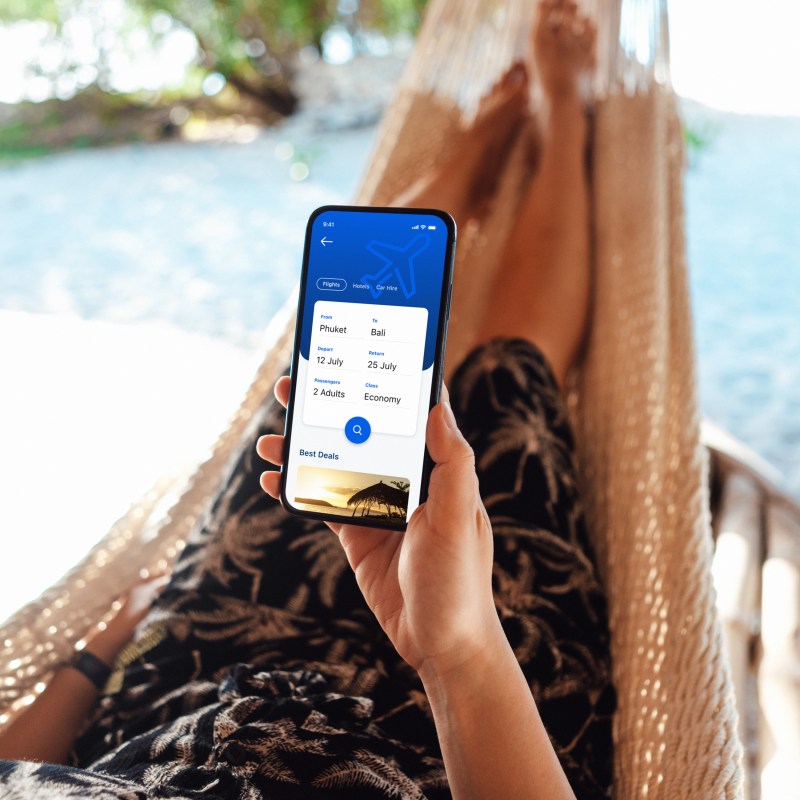
Travel apps are a tricky game.
Videos by TravelAwaits
Technology is constantly evolving, making exciting new features redundant quickly. On top of that, how we travel also influences the types of apps we use. Toss in new trends, like the recent rise of eSIMs, and tracking useful travel apps becomes a part-time position.
So, which travel apps do you actually need to download in 2025? And is there any difference between the types of apps that Apple users and Android users should download? Let’s dig in.
Let’s talk travel apps for a quick second
First, I want to let you know what to expect from the list below. I’m not going to discuss apps that let you plan travel—instead, I’m focusing on apps that you’ll need on the ground while you’re on vacation.
As an iPhone user, I’ve also found that some Apple apps are geared toward travelers like me. For example, the iPhone’s calculator app has a currency converter built in that works when my phone is offline, meaning I don’t need to worry about downloading a separate currency converter app.
The same is likely true for Android users, but because I’ve never used an Android smartphone, I don’t have those recommendations. In other words, this list isn’t exhaustive, and is geared toward Apple users.
11 essential travel apps for 2025
- Your airline’s app
- Your rental’s app
- A rideshare app like XYZ
- A jet lag solution like XYZ
- eSIM app like XYZ
- A currency converter like XYZ
- TripIt
- Google Translate
- Google Maps
- Find My Phone
- EchoSOS Emergency App
11 essential travel apps for 2025
Your airline’s app
I always download an airline’s app before flying with them. (I usually delete it once my trip is over, since I like a clean homescreen—so don’t be afraid to delete post-trip as long as you’ll remember to re-download.)
Airline apps are essential travel apps in 2025 because flights are prone to delays and hiccups more frequently than ever before. When you have an airline’s app downloaded, you can start problem-solving right from the palm of your hand instead of waiting to get through to an agent—from rescheduling flights to locating lost luggage.
Your rental’s app
Did you book a private rental via Airbnb, VRBO, or a similar platform? If you did, I highly recommend downloading the app so that you can troubleshoot if any issues arise. For example, you might need to get hold of your host if you can’t access your rental’s keys or if another issue comes up.
I don’t think this is the case with hotels because they have a concierge. The same with a car rental. Because you need to physically check in to get your keys (to a room or a vehicle), there’s less room for confusion.
A rideshare app like Freenow, Uber, Lyft, etc.
Every region has a different preferred rideshare app. Uber and Lyft are big in the US, but they aren’t live around the world. For this reason, I recommend researching your destination if you plan on using rideshares. You need to know which app to download in the first place.
Even if you plan on sticking to taxis and/or public transportation, I still recommend having a rideshare app downloaded and ready to go. Who knows what type of unexpected adventure will call on your next trip? With a rideshare app in your back pocket, you can get off the beaten path without worrying too much about how to get back your rental.
A jet lag solution like FlyKitt or Sleep Cycle
Jet lag can ruin a vacation in many subtle ways. As someone who really wants to guarantee that I get good sleep on a time-zone-hopping trip, I use jet lag prevention strategies. While you don’t necessarily need a jet lag app on the ground while you’re on vacation (because most of the work is done beforehand to plan to prevent jet lag), it never hurts.
If you want to keep it simple, use AI to plan around jet lag. But if you need to guarantee that you avoid the brunt of jet lag, I suggest using FlyKitt or Sleep Cycle. The former actually sends you a kit beforehand to prep for jet lag. I’ve been meaning to try them out for months now—I’ve heard rave reviews.
eSIM app like Saily, Firsty, & Airalo
If you’ve missed out on the eSIM zeitgeist, let me catch you up: using only an app, you can prep your phone for international usage by purchasing data plans. It’s really that easy. Just know that the old alternative is still an option.
As in, if you want to head to a mobile phone store at your destination, they can easily give you an eSIM card—it’ll probably be cheaper, too.
That being said, you can’t really beat the convenience of a prepaid eSIM plan. After all, unless you’re staying at your destination for a month or longer, finding a mobile phone shop probably isn’t on your to-do list. I’ve used eSIMs like Airalo for years, while Firsty and Saily are also great go-tos.
A currency converter
Like I already mentioned, my iPhone comes with a currency converter in the Apple calculator app. If you use an iPhone, there’s no need to download a separate currency converter app, as the calculator option works even when offline. If you’re an Android user, go with Currency. It also works offline.
When will you need a currency converter? I recommend having one handy if you’re going to shop at street markets and/or barter. In these cases, it’s helpful to have a converter on hand to avoid mistakes or scams.
A ‘Find My’ app
If you’re an Apple user, make sure you have Find My App downloaded and set up. That way, you can find your iPhone in case it’s lost or stolen. If you’re an Android user, use the Find My Device hub on Google. Today’s ‘Find My’ apps and services usually work even if your device has been powered off.
TripIt
TripIt is a travel planning app from Concur that instantly and seamlessly organizes all of your travel bookings in a single place. As an added perk, the app also adds your appointments to your calendar while also keeping track of your receipts.
Google Translate
Google Translate gives you live translations in 249 languages. That’s an insane number that will let you do things like read menus in Vietnam or figure out how to ask for the bathroom in Brazil. If you have the new Apple AirPods Pro 3, you can even translate live conversations.
Google Maps
Why do I prefer Google Maps to other map apps? First, because it has an offline feature, letting you save maps in case your service is spotty. Second, its live updates let you see where people are hanging out in a new city—which you can even use to find a place to stay. Third, Google Maps can also help you explore popular restaurants, shops, and more in tourist zones.
Just make sure you’re not following Google Maps suggestions into tourist traps.
EchoSOS Emergency App
As an avid traveler, I can tell you one of the worst questions to pop into your head on a trip—and that’s, ‘What’s the phone number for 911?!’ EchoSOS Emergency App can connect you to emergency services in any country. It will also ping your GPS location to emergency services in the region, if needed.
That being said, know that the emergency number in 81 countries is 112. Most of them are European. In Asia, emergency numbers are usually divided between medical emergencies, police emergencies, and fire emergencies.
